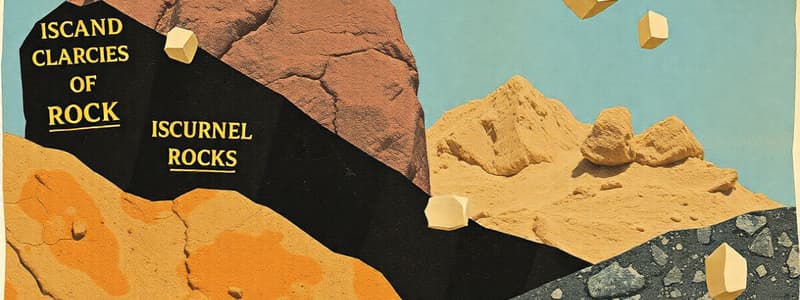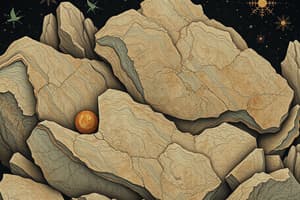Podcast
Questions and Answers
Which texture is characterized by very rapid cooling and no crystal formation?
Which texture is characterized by very rapid cooling and no crystal formation?
- Glassy texture (correct)
- Amygdaloidal texture
- Vesicular texture
- Trachytic texture
What type of rock is classified as having a medium-grained texture and is porphyritic?
What type of rock is classified as having a medium-grained texture and is porphyritic?
- Andesite (correct)
- Granite
- Basalt
- Peridotite
Which of the following rock types is categorized as felsic?
Which of the following rock types is categorized as felsic?
- Peridotite
- Basalt
- Andesite
- Granite (correct)
What is the primary characteristic of a pegmatitic texture?
What is the primary characteristic of a pegmatitic texture?
Which of the following statements about basalt is correct?
Which of the following statements about basalt is correct?
What defines an amygdaloidal texture in rocks?
What defines an amygdaloidal texture in rocks?
Which characteristic is typical of ultra mafic rocks?
Which characteristic is typical of ultra mafic rocks?
What is the typical cooling rate for rocks with coarse-grained texture?
What is the typical cooling rate for rocks with coarse-grained texture?
Which mineral is NOT typically found in felsic rocks?
Which mineral is NOT typically found in felsic rocks?
Flashcards
Plutonic Texture
Plutonic Texture
Very coarse-grained texture formed from slow cooling of magma.
Pegmatitic Texture
Pegmatitic Texture
Very coarse-grained texture formed from late-stage magma crystallization with high water and gas content.
Fine-Grained Texture
Fine-Grained Texture
Small mineral grains formed from rapid cooling of magma.
Amygdaloidal Texture
Amygdaloidal Texture
Signup and view all the flashcards
Glassy Texture
Glassy Texture
Signup and view all the flashcards
Vesicular Texture
Vesicular Texture
Signup and view all the flashcards
Intermediate Rock
Intermediate Rock
Signup and view all the flashcards
Mafic Rock
Mafic Rock
Signup and view all the flashcards
Acidic composition
Acidic composition
Signup and view all the flashcards
Study Notes
Igneous Rocks
- Igneous rocks form from the cooling and solidification of magma or lava.
- Factors affecting crystal size include:
- Amount of dissolved gases
- Cooling rate
- Texture refers to the shape, size, and appearance of mineral grains.
- Different textures include:
- Coarse-grained (plutonic): Slow cooling, large crystals. Example: Granite
- Fine-grained (volcanic): Rapid cooling, small crystals. Example: Basalt
- Porphyritic texture: Two distinct crystal sizes (large and small) formed by different cooling rates.
- Vesicular texture: Formed by volcanic gases being trapped in the rock. Example: Pumice
- Amygdaloidal texture: Minerals fill voids or vesicles.
- Glassy texture: Very rapid cooling, no visible crystals. Example: Obsidian
Igneous Rock Classification
-
Classified by mineral composition.
-
Felsic (granitic): Light-colored, high silica content, low density. Example: Granite
-
Intermediate: Medium-colored, intermediate silica content. Example: Andesite
-
Mafic (basaltic): Dark-colored, low silica content, high density. Example: Basalt
-
Ultramafic: Very dark-colored, very low silica content, very high density Example: Peridotite
-
Composition also influences viscosity, density, and color.
-
Intermediate and felsic rocks are often lighter in color compared to mafic and ultramafic rocks.
- felsic rocks = approximately 65-76% silica (SiO2)
- mafic rocks = approximately 45-52% silica (SiO2)
-
Crystallization, evaporation, and chemical compositions result in various textures.
Studying That Suits You
Use AI to generate personalized quizzes and flashcards to suit your learning preferences.




